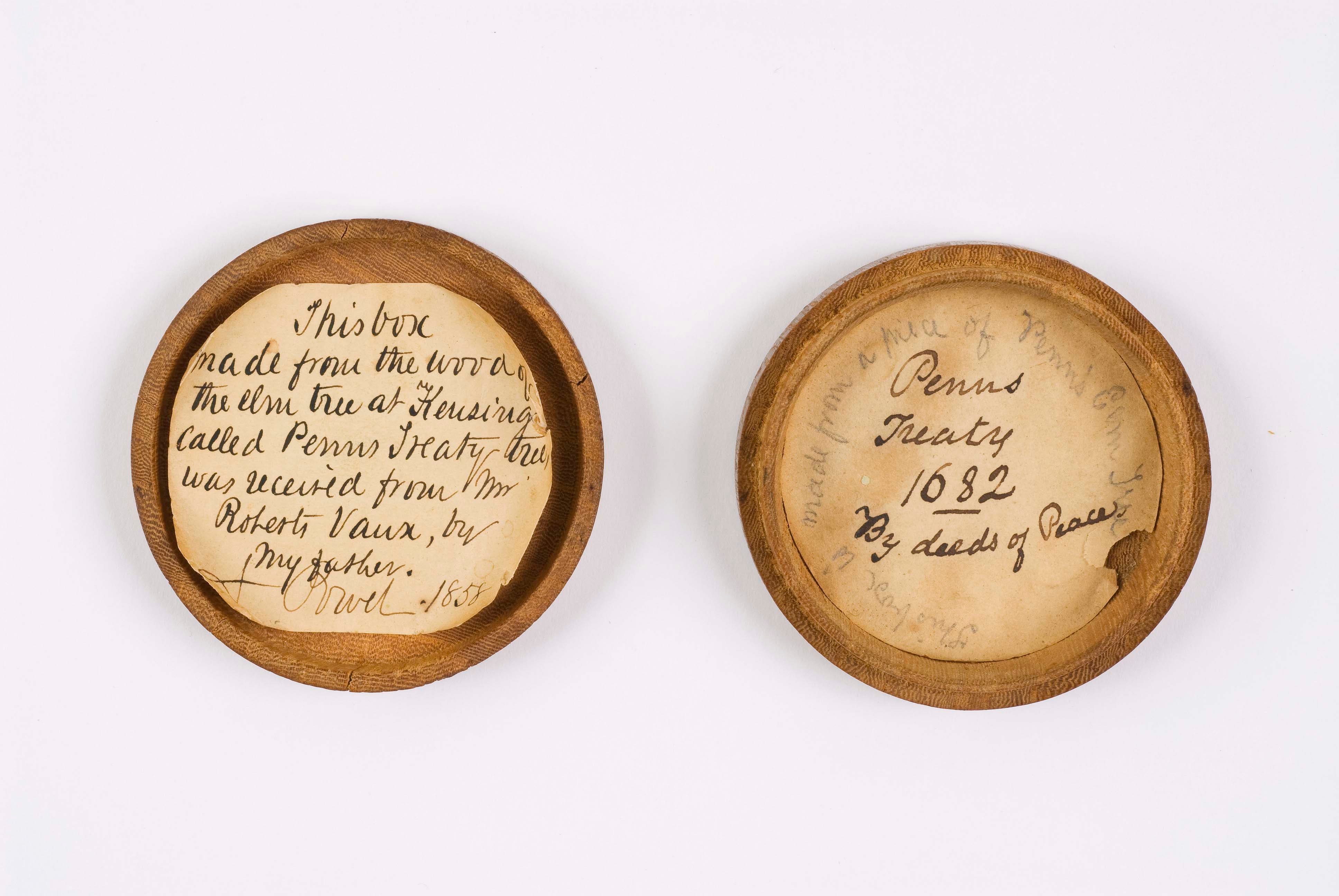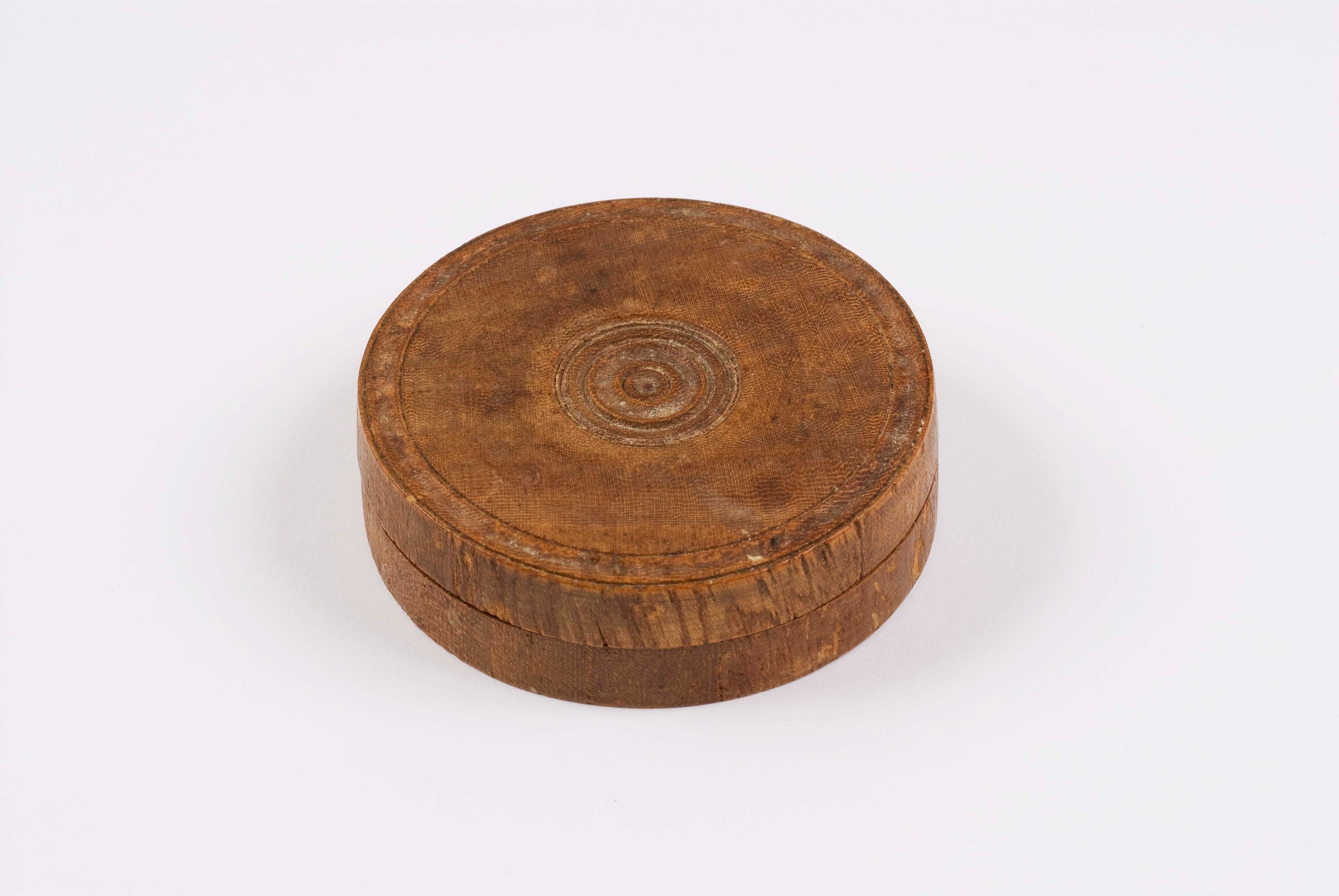National Museum of the American Indian treaty exhibition featuring Penn Treaty Museum artifact opens in September

This box, part of the Penn Treaty Museum Collection, will be on display as part of the National Museum of the American Indian’s treaty exhibition.
A box carved from the wood of the tree that witnessed the 1682 Treaty of Friendship forged by Lenni-Lenape Chief Tamanend and William Penn – and owned by a fledgling museum whose temporary HQ sits across the street from the treaty site – will be showcased in an upcoming National Museum of the American Indian exhibition.
Nation to Nation: Treaties Between the United States and American Indian Nations, will run Sept. 21 through Jan. 1 of 2018. The exhibition will examine treaties between American Indians and European powers, and American Indians and the nascent United States. It also explores the later shift in U.S. policy toward native peoples that resulted in the use of treaties to claim native lands, and 20th Century legislation upholding American Indian treaty rights.
Shaped like a hockey puck and small enough to hold in one hand, the Penn Treaty Museum’s box will be among the first items exhibit visitors see.
“Our introduction discusses the William Penn Treaty with the Lenape,” said National Museum of the American Indian Associate Director for Scholarship David Penney. “It was unusual to the extent that William Penn wanted to deal with the Lenape as equals, and recognized their status and the rightful owners of the land. He dealt with them in a nation-to-nation way.”
The tree was blown down in an 1810 storm, and the box likely made about a decade later, said Penn Treaty Museum Curator Penny Dwyer.
National Museum of the American Indian’s Penney said the box symbolizes both the hopefulness and respect of two peoples at the time the treaty was signed, and the subsequent dishonoring of those values by even William Penn’s own descendants. “The tree falling down was sort of an allegory of the United States’ deteriorating relations with Indians at that time,” he said.
“I’m extremely excited a piece of our collection is considered to be so noteworthy that it should be in an international-level exhibit,” said Penn Treaty Museum Board Member John Norwood, a Nanticoke Lenni-Lenape Tribal Councilman who is chair of the tribal government affairs and relations committee, principal justice of the Tribal Supreme Court. “It’s a particular honor that it’s the Museum of the American Indian that wants to display this symbol.”
Not bad for a museum with no permanent exhibition space, other than the internet. Occasional exhibits of the collection, often for school groups, are held by request in a Fishtown office building owned by museum founder John Connors, as are board meetings. This little box, as well as the bulk of the museum’s collection, was discovered and purchased by Connors, who recently donated the whole lot to the museum board. Penn Treaty hopes to find a permanent location that can regularly display and interpret the collection near the site of the Treaty of Friendship, also known as the Amity Treaty, The Shackamaxon Treaty and Penn Treaty.
The box is one of its most valuable assets, Dwyer said. She personally drove it to Washington, D.C. She hopes its inclusion in a significant, long-running exhibition will bring attention to Penn Treaty Museum, its efforts to find a permanent home, and its mission of keeping the memory of the peace treaty alive.
Norwood is hopeful the Museum of the American Indian will present the box and other objects and documents related to the treaty between Penn and Tamenend in context.
William Penn’s approach was “far more egalitarian than what we typically would see in the establishment of European Colonies.”
Penn took the time to learn the Lenape language and customs. The treaty meeting was held at Shackamaxon – present day Penn Treaty Park – the site where regional tribes traditionally met because it was centrally located and easily reached by rivers and streams. Wampum belts were exchanged. This treaty established peaceful relations and a desire to live side-by-side in peace, and in subsequent agreements, Penn “did acknowledge the native ownership of the land, and believed it was important to seek agreement when it came to occupying the land,” Norwood said.
But Penn believed he had the right to land that was given to him by a King who was not the proper owner of that land, Norwood said. “We know he presumed he would get the land before treaties were reached, because he already promised some portions of the land (to others) based on the Royal Charter, prior to actually getting it from the Lenape,” Norwood said.
Norwood said it’s important to give Tamenend and the other chiefs their proper share of the credit for the unique Treaty of Friendship, which the Lenape call the Shackamaxon Treaty.
“We celebrate William Penn, and his is a legacy worth celebrating, but it often overshadows the fact that what he did was within a context, and couldn’t have happened without the hospitality of the Lenape.”
The Lenape believed the land was given to them by The Creator, who wanted them to be its caretakers, Norwood explained. Because it was The Creator’s land, it was the Lenape’s duty to share it with anyone in need – and those original European settlers were most certainly in need.
The treaty tree was protected through the Revolutionary War, depicted in paintings and in popular culture, and while it stood and for about a century after it fell, was extremely well known, said Penn Treaty’s Dwyer, who in the past was assistant curator at the George Washington University Gallery and worked at the National Portrait Gallery.
When the tree fell, Roberts Vaux, a prominent Philadelphia attorney and philanthropist, who fought for the abolition of slavery and the rights of Native Americans, saved some of the wood.
About a decade later, he began giving boxes made from it to prominent people of the time, including President John Quincy Adams and Chief Justice John Marshall. This box came with a note written in 1858 saying that Vaux had given it to the note-writer’s father, a man named Powel. Dwyer said the museum needs to do more research to establish just who this Powel is, but it may be a member of the also-prominent Philadelphia family of Powels.
Vaux also fought for the marker on the spot where the Great Elm used to stand.
The Nation to Nation exhibition includes 125 objects from the museum collections and other lenders, including original treaties, photographs, wampum belts, textiles, baskets and peace medals.
Penney said its purpose is not only to remind museum visitors of the past, but to get them thinking about Native American issues as current events.
By 1810, many Eastern tribes had largely been forced to relocate west, he said. The falling of the symbolic tree may have had Americans thinking about the country’s obligations to its first residents. He hopes the exhibit will prompt similar reflections on those obligations.
“There’s a great deal of negotiation in the courts, and the legislature, dealing with obligation of treaties signed more than a century ago,” he noted.
Norwood said it is critically important that visitors remember Native Americans are not relics of the past, but “continuous and evolving” groups of people.
The Lenape, whom the Europeans named the Delaware, now live in several places, including Oklahoma and Canada. Those in the west have federal recognition; the Nanticoke Lenni-Lenape and related tribes in Northern New Jersey/New York and in Delaware, do not. They are descended from small groups of tribe members who stayed east and lived largely isolated lives, Norwood said. “We largely went unnoticed.”
The Nanticoke Lenni-Lenape were able to stay on land in South Jersey in part because Quakers didn’t force them to leave it, he said. Norwood noted both that fact and the ongoing friendship between the Lenape and Quakers, can be traced back to the treaty reached by Tamenend and Penn.

WHYY is your source for fact-based, in-depth journalism and information. As a nonprofit organization, we rely on financial support from readers like you. Please give today.



